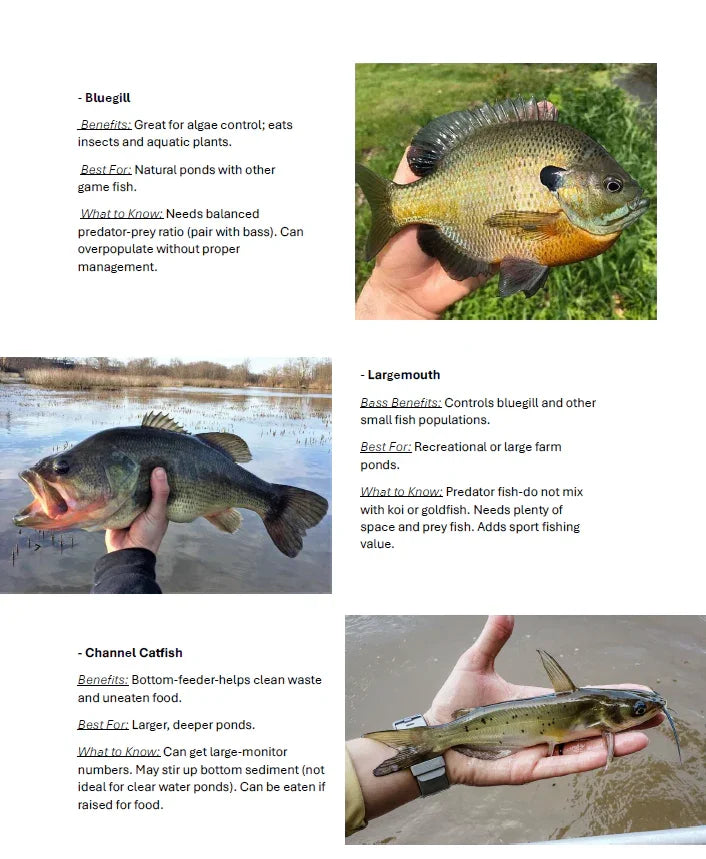Everything You Need to Know to Build a Balanced Pond Ecosystem
If you're a pond owner — whether managing a recreational fishing pond, a homestead water source, or just trying to keep your ecosystem healthy — stocking the right fish is one of the most important decisions you'll make. Today, we’re diving into three of the most popular and functional freshwater fish for North American ponds:
👉 Bluegill
👉 Largemouth Bass
👉 Channel Catfish
Each of these species brings unique benefits — but they also come with specific requirements and responsibilities. Here’s your go-to guide to help you make the best choice for your pond!
🟦 Bluegill: The Foundation of a Productive Pond
Why Pond Owners Love Them:
Bluegill are a forage fish, meaning they reproduce rapidly and serve as food for larger predator fish like bass. They also eat algae, aquatic insects, and small invertebrates — helping naturally balance your pond’s ecosystem.
Top Benefits:
-
Great for algae and insect control
-
Reproduce easily, creating a stable food chain
-
Easy to catch (great for kids and beginners)
-
Survive in a wide range of conditions
What to Watch Out For:
Bluegill can overpopulate quickly without predators like bass to keep them in check. Too many bluegill can lead to stunted growth and oxygen depletion.
Pro Tip: Always pair bluegill with a predator species like largemouth bass to maintain a healthy balance.
🎣 Largemouth Bass: The Natural Regulator
Why They Matter:
Largemouth bass are the top predator in many freshwater pond ecosystems. Their job? Keep the bluegill population under control. Without bass, you risk an overrun of small fish and algae issues.
Top Benefits:
-
Control bluegill and other small fish
-
Popular for sport fishing
-
Encourage a self-regulating ecosystem
-
Thrive in ponds with proper forage and structure
Things to Know:
-
Bass require plenty of bluegill or forage fish to stay healthy.
-
They need structure (like submerged logs or artificial habitats) for spawning and hiding.
-
Stock too few, and they won’t control your bluegill. Stock too many, and you may run out of food.
Recommended Ratio:
Stock 10 bluegill for every 1 bass to maintain a stable balance.
🐟 Channel Catfish: The Clean-Up Crew
What Makes Them Valuable:
Channel catfish are bottom-dwellers that help clean up uneaten food, decaying plant matter, and detritus at the pond floor. While they’re not algae-eaters per se, they improve water quality by reducing organic waste.
Top Benefits:
-
Great for pond bottom clean-up
-
Edible and popular for recreational fishing
-
Tolerant of murky, low-oxygen water
-
Can be stocked with bass and bluegill
Heads-Up:
Catfish don’t reproduce well in small ponds without nesting structures. If you want a sustainable population, you may need to restock periodically.
❓ Most Common Questions Pond Owners Ask:
Q1: Can I stock all three species together?
✅ Yes! Bluegill, bass, and channel catfish actually complement each other well when properly balanced.
Q2: What’s the best ratio for stocking?
For every acre of pond:
-
500–1,000 bluegill
-
100 bass
-
50–100 catfish
Always adjust based on pond size, depth, and goals.
Q3: Do I need to feed them?
You can feed catfish and bluegill with floating pellets to boost growth, especially in new or low-forage ponds. Bass usually prefer live prey.
Q4: Will catfish eat my bluegill or bass?
Not likely unless they’re large and the other fish are very small. They typically stick to the bottom and don’t chase fast swimmers.
Q5: Do I need an aerator?
While these fish are hardy, an aerator helps maintain oxygen levels, especially in hot weather or during seasonal turnovers.
🌿 Final Thoughts: Build a Self-Balancing Pond Ecosystem
When properly stocked, bluegill, largemouth bass, and channel catfish work together to create a healthy, sustainable pond that practically maintains itself.
They offer fishing fun, natural balance, and even water quality improvements — all without the need for chemical treatments or frequent interventions.
Want to go one step further? Pair your fish stocking strategy with beneficial bacteria and aeration to reduce algae, improve clarity, and keep your pond thriving year-round.
📥 Download our FREE Pond Fish Guide for a full breakdown of 9+ popular pond species, including stocking tips, benefits, and ecosystem compatibility.
🧠 Follow us for weekly pond wisdom, tips, and natural solutions that work 👉 @Pond Life Made Simple
📌 Hashtags:
#PondLifeMadeSimple #BackyardPond #BluegillPond #LargemouthBass #ChannelCatfish #PondFishGuide #NaturalPondCare #AlgaeControl #EcoFriendlyPond #SustainableFarming #PondManagement #AquacultureTips

